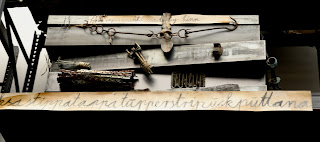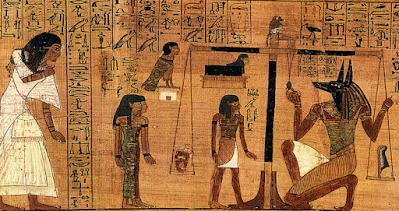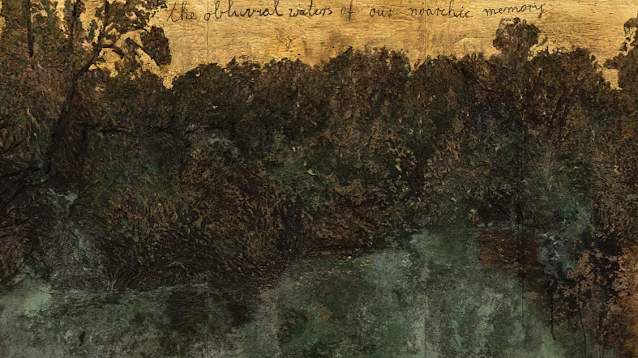This week Lisa and I went to see Anselm Kiefer's huge Finnegans Wake exhibition, at the White Cube gallery, a converted warehouse in Bermondsey. We were joined by Robert Worby, the composer and sound artist, who's a fellow member of the Glasgow Wake reading group.
I had the Wake on my kindle, so I was able to look up lots of the quotations as we went around the gallery.
On the left is an invocation to St Lawrence O'Toole, the patron saint of Dublin:'Beate Laurentie O’Tuli, Euro pra nobis!' 228.65
“It’s a kilometre long. All this stuff, it’s like my head, you know. Some was finished, some was not finished, and I thought: ‘It’s like going through the Finnegans Wake book!’”
Kiefer in a Guardian interview with Jonathan Jones.
'...blessed Kevin, exorcised his holy sister water, perpetually chaste, so that, well understanding, she should fill to midheight his tubbathaltar, which hanbathtub, most blessed Kevin, ninthly enthroned, in the concentric centre of the translated water, whereamid, when violet vesper vailed, Saint Kevin, Hydrophilos, having girded his sable cappa magna as high as to his cherubical loins, at solemn compline sat in his sate of wisdom, that handbathtub, whereverafter, recreated doctor insularis of the universal church, keeper of the door of meditation, memory extempore proposing and intellect formally considering, recluse, he meditated continuously with seraphic ardour the primal sacrament of baptism or the regeneration of all man by affusion of water.' 605.36-606.
'This is brave Danny weeping his space for the popers. This is cool Connolly wiping his hearth with brave Danny.' 303.08
You go in through long hanging rolls of paper, some with Wake quotations. So we walk right under the book's opening word 'riverrun', with the roll torn next to the r, because this is the second half of the book's final sentence.
 |
('Ora' changed to 'Euro', for Europe, and because the saint was buried in Eu in Normandy)
'But look what you have in your handself! The movibles are scrawling in motions, marching, all of them ago, in pitpat and zingzang for every busy eerie whig’s a bit of a torytale to tell.' 20.21
On the right, this line describing the book in our hands:
 |
| Robert Worby's photo |
This leads to a long dark corridor, a storage area with shelves. This is Kiefer's 'Arsenal 1970-2023', described in the catalogue as 'industrial racks with elements of steel, lead, copper, zinc, glass, wood, plaster, resin, silicone, terracotta, rocks, ashes, paper, cardboard, fabric, straw, earth debris, plant residue, oil and acrylic paint, shellac, sediment of electrolysis, photographic prints on paper, electrical and annealed wires.'
Kiefer in a Guardian interview with Jonathan Jones.
The first object I saw was this bucket in a tray.
This is Kiefer's imagining of the St Kevin of Glendalough's bath, one of the first pieces Joyce composed for the Wake, which ended up in the final book.
St Kevin was an early version of Shaun the Post, the upstanding conformist brother and rival of Shem the artist. So this introduces Shem and Shaun, and carries on the water theme of ‘riverrun’.
The line beneath St Kevin's bath comes from the studies chapter, where the twins are studying Irish history.
You can have fun looking for Shem and Shaun, who have many different names throughout the book.
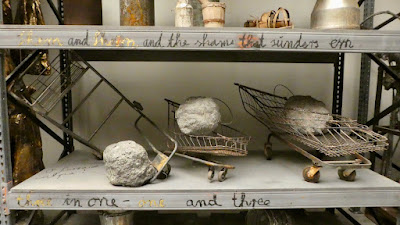 |
| Robert Worby's photo |
They fuse together to make a third figure, all three appearing in the Wake as soldiers who witness HCE's sin in the park. This is from the seance chapter, where the sleeping Yawn (Shaun) is being questioned about the three soldiers:
— Grenadiers. And tell me now. Were these anglers or angelers coexistent and compresent with or without their tertium quid?
— Three in one, one and three.
Shem and Shaun and the shame that sunders em.
Wisdom’s son, folly’s brother. 526.11
— Three in one, one and three.
Shem and Shaun and the shame that sunders em.
Wisdom’s son, folly’s brother. 526.11
The lines here are from a hymn of praise to Shaun, as Osiris, sung by a choir of 29 February girls:
Oisis, coolpressus onmountof Sighing! 470.15
It's based on the Latin text of the Book of Sirach 24.13:
'Quasi cedrus exaltata sum in Libano et quasi cypressus in monte Sion.' ( 'As cedar I was exalted in Lebanon and as cypress on Mount Zion).
Here's a rare example of Kiefer misquoting - he's changed 'sighing' to 'sighihing'.
In the second level, there's a Hebrew quotation from the children's games chapter, which Joyce called The Mime of Mick, Nick and the Maggies (219.17), and which ends with thunder:
'And let Nek Nekulon extol Mak Makal and let him say unto him: Immi ammi Semmi.' 258.10
Nek Nekulon and Mak Makal are Shem and Shaun (Nick and Mick). In Hebrew, 'immi, ammi, shmi' means 'my mother, my nation, my name.' So this is Shem saying 'I am Shem' to his brother.
'Home all go Halome' (256.11) beneath the bones is the calling in of the children after their games.
'The mausoleum lies behind us' (81.05) is from a description of the Wake landscape.
'Sleep in the water, drug at the fire, shake the dust off and dream your one who would give her sidecurls too' (280.34), from the lessons chapter, is a list of the four elements.
This book on top of a concrete slab is 'The hundredlettered name again, last word of perfect language'. 424.23 - the last of ten thunderwords in the book.
'Our wholemole millwheeling vicociclometer, a tetradomational gazebocroticon... autokinatonetically preprovided with a clappercoupling smeltingworks exprogressive process' 614.27
Nearby, there's an Athanor, an alchemist's furnace. For both Joyce and Kiefer, art is an alchemical process, hence all the lead - the base matter to be changed into gold.
'Of course our low hero was a self valeter by choice of need so up he got up whatever is meant by a stourbridge clay kitchenette and lithargogalenu fowlhouse for the sake of akes (the umpple does not fall very far from the dumpertree) which the moromelodious jigsmith, in defiance of the Uncontrollable Birth Preservativation (Game and Poultry) Act, playing lallaryrook cookerynook, by the dodginess of his lentern, brooled and cocked and potched in an athanor, whites and yolks and yilks and whotes to the frulling fredonnance... ' 184.10
This is based on an attack on Joyce by Percy Wyndham Lewis (a model for Shaun), in which he described the bric-a-brac of Ulysses:
'It lands the reader inside an Aladdin's cave of incredible bric-à-brac, in which a dense mass of dead stuff is collected, from 1901 toothpaste, a bar or two of sweet Rosie O'Grady, to pre-nordic architecture. An immense nature-morte is the result. This ensues from the method of confining the reader in a circumscribed psychological space into which several encyclopaedias have been emptied....It is a suffocating, moeotic expanse of objects, all of them lifeless, the sewage of a Past twenty years old.'
'last four occupants carried out, mental companionship with mates only, respectability unsuccessfully aimed at, copious holes emitting mice, decoration from Uganda chief in locked ivory casket, grandmother has advanced alcoholic amblyopia...' 545.06
The 'companionship with mates' and 'holes emitting mice' are both Rowntree quotations. Joyce must have read about a Uganda chief somewhere, but nobody's found it yet.
'fair home overcrowded, tidy but very little furniture, respectable, whole family attends daily mass and is dead sick of bread and butter, sometime in the militia, mentally strained from reading work on German physics, shares closet with eight other dwellings, more than respectable, getting comfortable parish relief' 543.22
'She cancelled all her engauzements. She climbed over the bannistars; she gave a childy cloudy cry: Nuée! Nuée! A lightdress fluttered. She was gone. And into the river that had been a stream (for a thousand of tears had gone eon her and come on her and she was stout and struck on dancing and her muddied name was Missis- liffi) there fell a tear, a singult tear, the loveliest of all tears...for it was a leaper.' 159.08
'Numerous are those who, nay, there are a dozen of folks still unclaimed by the death angel in this country of ours today, humble indivisibles in this grand continuum, overlorded by fate and interlarded with accidence, who, while there are hours and days, will fervently pray to the spirit above that they may never depart this earth of theirs till in his long run from that place where the day begins, ere he retourneys postexilic, on that day that belongs to joyful Ireland, the people that is of all time, the old old oldest, the young young youngest, after decades of longsuffering and decennia of brief glory, to mind us of what was when and to matter us of the withering of our ways...' 472.28
So the movement from the lead on the floor to the gold skies is another alchemical reference.
'The oaks of ald now they lie in peat yet elms leap where askes lay. Phall if you but will, rise you must: and none so soon either shall the pharce for the nunce come to a setdown secular phoenish.' 4.13
'When I was born I was in the hospital with my mother in the cellar. And then this night our house was bombed. If they hadn’t been in the hospital they would be dead, me included. It’s interesting, no? And then as a child I had no Spielzeuge – no toys. So I built all these houses with the bricks from the ruin. I had all that I wanted. Because my family had moved into the house next to this bombed house. I was next to the ruins, it was fantastic. As a child you don’t judge. You take what it is and keep it. For me it was not a catastrophe. It was my toys.'
On one wall, there's a big dark painting of sunflowers.
'— Capilla, Rubrilla and Melcamomilla!' 492.12
Finnegans Wake is also full of snakes, enemies of HCE:
' Sss! See the snake wurrums everyside! Our durlbin is sworming in sneaks.' 19.12
Here you can see four levels of objects, all repurposed with Wake quotations, most relating to Shem and Shaun.
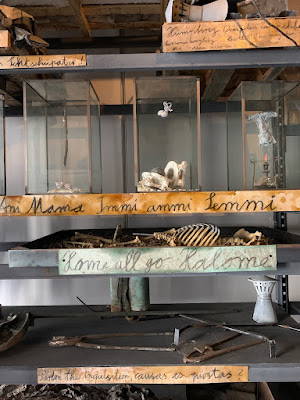 |
| Robert Worby's photo |
At the top left there's an exclamation from Butt (Shem), in the stories chapter: 'Greates Schtschuptar!' 343.21. It's a play on Greatest Jupiter - the thunder god. On the right we see names for HCE, the father and Big Man in the Wake (Jupiter to the children): Humphrey Chimpden Earwicker, Here Comes Everybody, Haveth Childers Everywhere, Noah and Adam.
 |
| Frederick J Haynes' photo |
'Ani Mama' on the left is from this passage:
'Ani Mama and her fierty bustles' 243.04
That combines Hebrew 'Ani' (I am) with Anna Mamma (ALP), Jung's anima, and Ali Baba and the Forty thieves.
At the bottom there are pincers as instruments of torture used by the Spanish Inquisition, from the Stories chapter: 'Pardon the inquisition, causas es quostas?' (342.10).
At the far end of the corridor Kiefer has created a mechanical model of Finnegans Wake, viewed as a ‘vicociclometer’, a machine driven by Vico's historical cycles:
'Our wholemole millwheeling vicociclometer, a tetradomational gazebocroticon... autokinatonetically preprovided with a clappercoupling smeltingworks exprogressive process' 614.27
 |
| Photo from Jonathan Brooker |
Nearby, there's an Athanor, an alchemist's furnace. For both Joyce and Kiefer, art is an alchemical process, hence all the lead - the base matter to be changed into gold.
Kiefer has used the title 'Athanor' for several works, including a painting of the burned Reich Chancellory.
Shem the Penman, Joyce's self-portrait, is an 'alshemist', who transmutes base matter (shit and urine) into ink, which he uses to write on his own body:
'the first till last alshemist wrote over every square inch of the only foolscap available, his own body, till by its corrosive sublimation one continuous present tense integument slowly unfolded all marryvoising moodmoulded cyclewheeling history' 185.34
Shem cooks his food in an athanor:
Shem cooks his food in an athanor:
'Of course our low hero was a self valeter by choice of need so up he got up whatever is meant by a stourbridge clay kitchenette and lithargogalenu fowlhouse for the sake of akes (the umpple does not fall very far from the dumpertree) which the moromelodious jigsmith, in defiance of the Uncontrollable Birth Preservativation (Game and Poultry) Act, playing lallaryrook cookerynook, by the dodginess of his lentern, brooled and cocked and potched in an athanor, whites and yolks and yilks and whotes to the frulling fredonnance... ' 184.10
 |
| Robert Worby's photo |
Like several of the quotations in the Arsenal, 'seedy ejaculations' and 'unused mill and stumbling stones' are taken from Shaun's descriptions of Shem the Penman's house, the Haunted Inkbottle, which could also be a description of the exhibition:
'The warped flooring of the lair and soundconducting walls thereof, to say nothing of the uprights and imposts, were persianly literatured with burst loveletters, telltale stories, stickyback snaps, doubtful eggshells, bouchers, flints, borers, puffers, amygdaloid almonds, rindless raisins, alphybettyformed verbage, vivlical viasses, ompiter dictas, visus umbique, ahems and ahahs, imeffible tries at speech unasyllabled, you owe mes, eyoldhyms, fluefoul smut, fallen lucifers, vestas which had served, showered ornaments, borrowed brogues, reversibles jackets, blackeye lenses, family jars, falsehair shirts, Godforsaken scapulars, neverworn breeches, cutthroat ties, counterfeit franks, best intentions, curried notes, upset latten tintacks, unused mill and stumpling stones, twisted quills, painful digests, magnifying wineglasses, solid objects cast at goblins, once current puns, quashed quotatoes, messes of mottage, unquestionable issue papers, seedy ejaculations, limerick damns, crocodile tears, spilt ink, blasphematory spits...' 183.08
Unlike Shaun who, as St Kevin, takes to a bathtub, Shem lives surrounded by filth.
'It lands the reader inside an Aladdin's cave of incredible bric-à-brac, in which a dense mass of dead stuff is collected, from 1901 toothpaste, a bar or two of sweet Rosie O'Grady, to pre-nordic architecture. An immense nature-morte is the result. This ensues from the method of confining the reader in a circumscribed psychological space into which several encyclopaedias have been emptied....It is a suffocating, moeotic expanse of objects, all of them lifeless, the sewage of a Past twenty years old.'
Time and Western Man.
Off the corridor, there's a tall square white room, with shelving and vitrines.
This vitrine has a 'Uganda chief in locked ivory casket', which comes from a description of Dublin squalor, in the Haveth Childers Everywhere section, one of the funniest parts of the book.
It's based on Rowntree's Poverty: A Study of Town Life, which repeatedly uses the term 'respectable':
The whole section anticipates the William Burroughs cut-up method. Here's another quotation from it:
Kiefer has selected 'mentally strained from reading work on German physics', which is from this section in Rowntree:
He's placed this beneath a DNA double helix, and another ruin with fallen buildings.
Here's part of one of Joyce's ten 100 letter thurderwords, this one made up of different words for prostitute, plus 'bloody awful', 'foul', 'lady', 'strip' and Mecklenburg Street, the brothel district of Dublin.
Robert suggested that the clothes hanging in a row beneath the tree on the left represent the washerwomen’s laundry.
The double helix, which wasn't discovered until 1953, 14 years after Finnegans Wake was published, often features in Kiefer's work.
Above the Uganda chief vitrine, the squalor theme continues with Dublin's brothels.
Bladyughfoulmoecklenburgwhurawhorascortastrumpapornanennykocksapastippatappatupperstrippuckputtanach, eh? 90.31
It continues lower down, on the right side of the Uganda chief.
In the same space we can see the transformation of the washerwomen, at the end of the Anna Livia chapter, into a rock and a tree. I love the way he's placed this massive rock so high up.
The photo at the bottom is captioned ‘TAFF a smart boy’ (338.05) a name for Shaun in the stories chapter.
This is the younger washerwoman, Miss Dodpebble, transformed into 'an oldsteinsong' 231.21
Here the older washerwoman, Mrs Quickenough, is being changed into a tree.
'Look, look, the dusk is growing! My branches lofty are taking root.' 213.12
The tree stands for time, while the stone stands for space.
Here you can see the woman being changed into a tree at the top right.
Beneath there's a vitrine with the text from a pompous professorial lecture by Shaun about Shem: 'the reason I went to Jericho must remain for certain reasons a political secret' (150.19)
 |
| Robert Worby's photo |
This looks like the crumbling walls of Jericho.
Here's another vitrine, showing the weighing of the heart scene from the Papyrus of Ani, a version of the Egyptian Book of the Dead. A model for Finnegans Wake, its proper title was 'Chapters of Coming Forth by Day'.
 |
| Robert Worby's photo. |
The quotation on the glass is from the opening of Book III:
‘And low stoke o’er the stillness the heartbeats of sleep.’ 403.05
The amorphous shape behind the scales has appeared in previous Kiefer paintings and sculptures, often titled 'Emanation'.
Here Ani's heart is weighed against a feather of truth (Maat), and found to be lighter, allowing him to come forth by day in the kingdom of Osiris.
There are more than 133 quotations from the Book of the Dead in Finnegans Wake, listed here in fweet.
This vitrine shows Issy as Nuvoletta, the cloud girl, a famous lyrical passage set to music by Samuel Barber.
The passage ends with her falling as a raindrop into the river:
Kiefer's captured the atmosphere of that in those hanging white gowns.
'The aged monad making a venture out of the murder of investment.'341.13
'he would go good to him suntime marx my word fort, for a chip off the old Flint' 83.09
In a side gallery, Kiefer has created a huge pile of sand, with shopping trolleys half buried in it - an image of the collapse of capitalism? The wall quotations are political/ economic references from different parts of the Wake:
'Our bourse and politicoecomedy are in safe with good Jock Shepherd, our lives are on sure in sorting with Jonathans, wild and great.' 540.26
 |
| Robert Worby's photo |
On the side of the sand mound, there's a huge painting of the still living people of Ireland, 'humble indivisibles in the grand continuum', longing for the return of Jaun (Shaun):
'Numerous are those who, nay, there are a dozen of folks still unclaimed by the death angel in this country of ours today, humble indivisibles in this grand continuum, overlorded by fate and interlarded with accidence, who, while there are hours and days, will fervently pray to the spirit above that they may never depart this earth of theirs till in his long run from that place where the day begins, ere he retourneys postexilic, on that day that belongs to joyful Ireland, the people that is of all time, the old old oldest, the young young youngest, after decades of longsuffering and decennia of brief glory, to mind us of what was when and to matter us of the withering of our ways...' 472.28
.
 |
| Detail, from Jonathan Brooker |
At the top the sky looks like it's exploding, and there are shoes and clothes stuck to the painting.
The north gallery is a river room, with twelve huge paintings of the Liffey, beneath a golden sky. Each carries a quotation describing the river. 'O nilly, not all, here's the fuss cartaraction!' 'When Adam was delvin and madameen spinning waters tilts, 'The obluvial waters of our noarchic memory', 'The dead sea dugong updripdripping from his depths', 'A stream, alplapping coyly coiled um, cool of her curls', 'You're welcome to Waterford', 'Woman will water the wild world over', 'Galawater and fragrant pistania mud', and 'Warming along gradually for our savings backwards mother water.'
Kiefer says these paintings, made in 2023, are based on the Rhine.
On the floor, there are 29 lead covered books (the number of Issy and her girl companions). I found out afterwards that visitors can turn the pages, though this creates a cloud of dust.
 |
 |
| Photo from Jonathan Brooker |
The biggest piece is a vast ruin made of shattered concrete and barbed wire in the South Gallery. This is called 'Phall if you will but rise you must', illustrating this passage on cyclical renewal:
 |
| Jonathan Brooker's photo |
 |
| Robert Worby's photo |
Sunflowers are a favourite subject for Kiefer.
'First the sunflower is connected with the stars, because it moves its head against the sun. And in the night it’s closed. The moment they explode they are yellow and fantastic: that’s already the declining point. So sunflowers are a symbol for our condition d’etre.'
Kiefer to Jonathan Jones in the Guardian interview.
The first Wake quote on the painting is from a passage where the 29 February girls celebrate Shaun:
'the phalanx of daughters of February Filldyke, embushed and climbing, ramblers and weeps, voiced approval in their customary manner by dropping kneedeep in tears over their concelebrated meednight sunflower, piopadey boy, their solase in dorckaness...' 470.04
The second is from the seance chapter, and is spoken by ALP through Yawn (Shaun), referring to her red hair.
'— Capilla, Rubrilla and Melcamomilla!' 492.12
Another favourite subject of Kiefer's is the snake, whose multiple meanings he has discussed in an interview in the Gagosian Quarterly.
 |
| Dorothy Max Prior's photo |
Finnegans Wake is also full of snakes, enemies of HCE:
' Sss! See the snake wurrums everyside! Our durlbin is sworming in sneaks.' 19.12
'Wriggling reptiles, take notice!' 616.16
'It it must be remembered that stuttering, according to the modern psychologists, is a neurotic symptom caused by a consciousness of guilt.. Joyce is suggesting that the original masterbuilder is God and that He stutters when His voice is heard in the thunder — thus proving that He is conscious of having committed a sin!
To one side of the ruin is a big painting of the Wake family, with HCE as a shadowy absence on the left. Robert Worby suggested that they are wearing hazmat suits and holding metal detectors to look for mines.
 |
| Photo from Jonathan Brooker |
Kiefer is most interested in this core Wake family grouping - HCE, ALP, Shem, Shaun and Issy. Apart from the 29 February girls and the two washerwomen, I didn't find Joyce's larger cast of characters - the four old men (Mamalujo), the twelve drinkers/jurymen/critics who represent public opinion, and the two old servants, Kate and Joe.
Kiefer has made a great selection of quotations, illustrating Joyce's diverse styles in writing Finnegans Wake. The whole show is a perfect introduction to the book. I wonder how many of the visitors will go away and start reading it.
I assumed that all the texts were quotations from Joyce, but Frederick J Haynes, on Twitter, shared this photograph of a vitrine I missed:
 |
| Photo by Frederick J Haynes |
The small lead tunic hovering over a candle, like a hot air balloon, is an image also used above 'Immi Ammi Semmi' above. Is this an image of God? Beneath two German WW2 soldiers run towards each other with a ruin behind them.
The text here is not from Joyce, but it describes a controversial theory put forward by J.S.Atherton, in The Books at the Wake, based on the book's stuttering thunderclaps:
This attribution of Original Sin to God is one of the basic axioms of Finnegans Wake. '
The Books at the Wake, 1960, p
Here Rod Mengham interviews Kiefer in the river room.
Thanks to Robert Worby, Dorothy Max Prior, Frederick J Haynes and Jonathan Brooker for sharing their photos.














